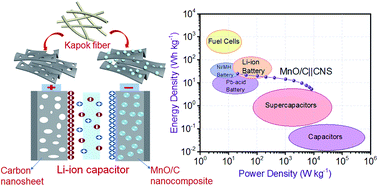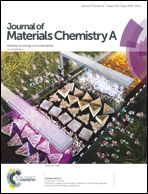Two-dimensional biomass-derived carbon nanosheets and MnO/carbon electrodes for high-performance Li-ion capacitors†
Abstract
Li-ion capacitors have been considered as next-generation advanced energy storage systems to meet the requirements of both high energy and high power due to the combination of rapid and long-term charge storage of supercapacitors and the high energy storage capacity of lithium ion batteries. Herein, we demonstrate the design of 2D nanostructured electrodes from low-cost biomass-kapok fiber for Li-ion capacitors: 2D carbon nanosheets with a high surface area and hierarchical porosity for the positive electrode, and 2D MnO/C nanocomposites with a large surface area and nanosized particles for the negative electrode. With the benefit of the structure of the Li-ion capacitor, the hybrid device can be operated at a high operating voltage of 4 V, exhibiting a high energy density of 100 W h kg−1 at 83 W kg−1, a high power density of 20 kW kg−1 at 30 W h kg−1 based on the active materials, and a capacity retention ratio of 70% after 5000 cycles. These results clearly demonstrate that biomass-derived electrodes are potential candidates for low-cost, fast and efficient energy storage systems in the future.



 Please wait while we load your content...
Please wait while we load your content...